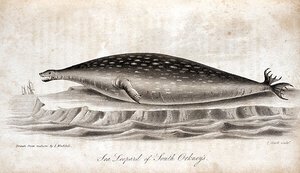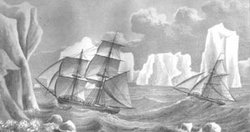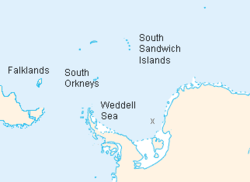James Weddell
Weddell, James
James Weddell (1787-1834) was a British seaman who contributed to the exploration of the Antarctic.
In 1796, at the age of young age of nine, Weddell joined the British navy, but was discharged six months later. Next, he joined the crew of a ship moving coal, before, in 1805, joining a ship that traded in the West Indies. In 1810, Weddell was back in the navy and six months later was acting master of his first ship. In 1813, in command of the ten gun brig, the Hope, Weddell captured an American privateer, True Blooded Yankee, in the English Channel. In 1816, with the end of the Napoleonic Wars, the navy scaled back in size and Weddell left the service to resume plying trading ships to the West Indies.
In late 1819, Weddell gained command of the brig Jane just as news of the discovery of the South Shetland Islands by William Smith was spreading. Weddell immediately headed south to hunt seals. Rather than going immediately to the South Shetlands, he looked for islands reported by Spanish explorers that proved not to exist, beyond a few rocks two hundred miles from their reported location. Weddell spend the middle of 1820, the southern winter, at the Falkland Islands. In late 1820, the Jane joined over fifty American and British sealing boats that descended on the South Shetlands to hunt seals. In January, the Jane headed for home with a hold full of seal pelts.
Weddell's return to England was brief. A second smaller ship, the Beaufoy, was acquired with the profits of the first voyage to the South Shetlands to serve as a tender to the Jane on a second voyage.
Weddell was back in the South Shetlands in October of 1821 along with many others. The seal population of the the South Shetland Islands had already dramatically reduced during the prior season and by the end of the year, seal hunters were beginning the look for new sources of seals. In December of 1821, George Powell and Nathaniel Palmer had discovered the South Orkney Islands several hundred miles to the east of the South Shetlands. The Jane visited the new islands in February, 1822 and Weddell made a preliminary chart of them before returning the England.The second voyage to the South Shetland Islands turned a smaller profit than the first, but enough to warrant a third journey south. The Jane and the Beaufoy departed London in September 1822.
After a delay to repair a leak in the Jane, the ships were again in the South Orkney Islands January, 1823.The few seals killed on the South Orkneys were unusual in appearance, so Weddell recovered the skulls and preserved them and the skins. This species of seal is now known as the Weddell Seal.
From a peak on the South Orkneys other, more distant peaks to the south were sighted. The Jane and the Beaufoy reached them but, as was often the case, icebergs had been mistaken for land. Weddell decided to continue south to search for new lands and sources of seal. On January 27th, they reached 64° (degrees) 58' (minutes south), about 300 miles (480 Km) south of the islands. Weddell realized they were south of the South Shetlands and "Trinity Land" (Trinity Peninsula, the northernmost part of the Antarctic Peninsula sighted by William Smith and Edward Bransfield).
Here Weddell decided to search for land between the South Orkney Islands and the South Sandwich Islands which lay 600 miles (960 Km) further east. On February 4, Weddell was within 100 miles (160 Km) of the South Sandwich Islands and concluded that there was no new land in that area and turned south again. For the next twelve days the ships battled adverse and bitterly cold winds until the weather suddenly calmed and became mild. Another sighting of land turned out to be an iceberg crusted with rocks. By February 17th, they reached 71° 34' South, a new record, surpassing James Cooks record set in 1774. Three days later, the Jane and the Beaufoy were at 74° 15' S, 34° 16' W and, but for icebergs, open sea ahead.
Here Weddell opted for caution and turned north. The weather had been unusually calm and mild, but it was getting late in the season and the ships could easily find themselves trapped by ice, a fatal outcome. Weddell even wondered if the would be land to find further south and not merely sea and ice all the way to the south pole. He was wrong in this. After sailing 1000 miles (1600 Km) south, another 170 miles (270 Km) east and south would have brought Weddell to the Antarctic continent (Coat's Land and the Filchner Ice Shelf). Whether the ice was clear enough for Weddell have reached those areas, is not known. Whether he, his crew, and ships, would have returned is also unknown.
The regions into which Weddell sailed are usually covered with ice, even in the summer. It would be 80 years until anyone advanced so far in this region, and then with much superior ships. Other ships would become trapped in ice and crushed attempting the same.
Weddell named this new sea, east and south of the South Shetlands and Trinity Land, King George IV's Sea, how is is now known as the Weddell Sea.
Sailing 1200 miles north, the Jane and the Beaufoy reached South Georgia and rested for a month, before sailing to the Falkland Islands where the spend the southern winter of 1823.
In October 1823, Weddell sailed for the South Shetland Islands but met a fierce storm and heavy ice cover. He then sailed north to Cape Horn to look for seals and then to the Falklands (Beaufoy) and Patagonia (the Jane) for both seals and whales. He returned to England in July, 1824.
In 1827, Weddell published is account of the voyage in "A Voyage Towards the South Pole, Performed in the Years 1822-24; Containing an Examination of the Antarctic Sea."
Weddell put himself forward to the British navy to lead new voyages of discovery in 1826 but was turned down, returned to trading with the Jane. In 1829 the ship was no longer seaworthy and was abandoned in the Azores along with much of Weddell's financial standing. He continued as a ship Master until 1832. Weddell died September 1834, aged 47.
See Also
Further Reading
- A Voyage Towards the South Pole, Performed in the Years 1822-24; Containing an Examination of the Antarctic Sea (1827), James Weddell, David & Charles, 1970 ISBN: 0715348922.
- Below the Convergence: Voyages Towards Antarctica, 1699-1839, Alan Gurney, W.W. Norton and Company, 1997 ISBN: 0393039498.
- Antarctica: Exploring the Extreme: 400 Years of Adventureby Marilyn J. Landis, Chicago Review Press, 2001 ISBN: 1556524285.
- South Pole: A Narrative History of the Exploration of Antarctica by Anthony Brandt, NG Adventure Classics, 2004ISBN: 0792267974.
- Exploring Polar Frontiers: An Historical Encyclopedia, William James Mills, ABC-CLIO, 2003 ISBN: 1576074226.
- James Weddell, Andre Engels (accesed November 29, 2008)



